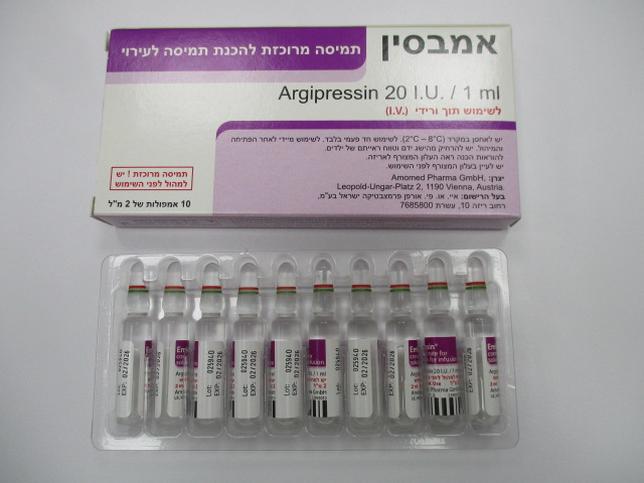Quest for the right Drug

אמבסין EMBESIN (ARGIPRESSIN)
תרופה במרשם
תרופה בסל
נרקוטיקה
ציטוטוקסיקה
צורת מתן:
תוך-ורידי : I.V
צורת מינון:
תרכיז להכנת תמיסה לאינפוזיה : CONCENTRATE FOR SOLUTION FOR INFUSION
עלון לרופא
מינוניםPosology התוויות
Indications תופעות לוואי
Adverse reactions התוויות נגד
Contraindications אינטראקציות
Interactions מינון יתר
Overdose הריון/הנקה
Pregnancy & Lactation אוכלוסיות מיוחדות
Special populations תכונות פרמקולוגיות
Pharmacological properties מידע רוקחי
Pharmaceutical particulars אזהרת שימוש
Special Warning עלון לרופא
Physicians Leaflet
Pharmacological properties : תכונות פרמקולוגיות
Pharmacodynamic Properties
5.1 Pharmacodynamic properties Pharmacotherapeutic group: Vasopressin and analogues, ATC code: H01BA01 Mechanism of action Argipressin (arginine vasopressin) is an endogenous hormone with osmoregulatory, vasopressor, hemostatic, and central nervous effects. Peripheral effects of arginine vasopressin are mediated by different vasopressin receptors, namely V1a-, V1b-, and V2-vasopressin-receptors. V1-receptors have been found in arterial blood vessels, and induce vasoconstriction by an increase in cytoplasmatic ionized calcium via the phosphatidyl- inositol-bisphosphonate cascade, which is the most prominent effect of argipressin. During vasopressin infusion a linear blood pressure response can be seen in patients in vasodilatatory shock (septic, vasoplegic and SIRS = systemic inflammatory response syndrome). Specifically, a significant correlation was demonstrable between baseline corrected MAP changes and the vasopressin dose. A comparable significant linear relationship was demonstrable between vasopressin doses and the increase in peripheral resistance as well as the decrease in norepinephrine requirements. A decrease in heart rate has been observed in patients with septic shock while vasopressin was initiated and catecholamines were reduced in parallel. In a study in human volunteers, investigating the effect of vasopressin infusion after lisinopril, heart rates decreased from 67 +/- 6.5 to 62 +/- 4.5 beats/min (P < 0.05). A suppression of heart rate and cardiac index (CI) may only be expected at a dose range of 0.1 IU/min and higher Clinical efficacy The clinical evidence for efficacy of argipressin in the claimed indication of hypotension following catecholamine-refractory septic shock is based on analysis of several clinical trials and publications. A total of 1,588 septic shock patients who have been treated with vasopressin under controlled conditions to date have been included in this analysis. The largest investigation of vasopressin in septic shock was a multicentre, randomized, double-blind trial (VASST trial), where a total of 778 patients with septic shock were randomized to receive either low-dose vasopressin (0.01 to 0.03 IU/min) or norepinephrine (5 to 15 µg/min) in addition to open label vasopressors. Patients who were 16 years or older and had septic shock resistant to fluids, defined as lack of response to 500 ml of normal saline, or a requirement for vasopressors or low-dose norepinephrine, were considered for enrolment. Patients needed to have received ≥ 5 μg/min of norepinephrine or equivalent for at least six consecutive hours in the preceding 24 hours and to have received at least 5 μg/min within the last hour prior to randomization or norepinephrine equivalent > 15μg/hr for three consecutive hours. The primary endpoint was death of any cause and was assessed 28 days after initiation of the study drug. There was no significant difference between the vasopressin (35.4%) and the norepinephrine (39.3%) groups (95% confidence interval -2.9% to +10.7%; p=0.26). Similarly, there was no significant difference in the mortality rate at 90 days (43.9% and 49.6%, respectively; p=0.11). In a recent double blind randomised study (VANISH) comparing norepinephrine to early argipressin (up to 0.06 U/min) mortality in the argipressin group was 30.9% and in the norepinephrine group was 27.5%. One or more serious adverse events were seen in 10.7 % of argipressin and 8.3% of norepinephrine patients. Significantly less renal replacement therapy was necessary in the argipressin group compared to the norepinephrine group (25.4% vs 35.3%). Effects on QT and QTc Experimentally high doses of vasopressin were shown to induce ventricular arrhythmias in animals. In the intended dose range and application form (chronic infusion) QT and QTc prolongation is not described. Single cases of torsade de point tachycardias in patients receiving vasopressin for the treatment of esophageal variceal bleedings with doses more than 10 times the recommended level have been described but no final conclusions on the torsadogenic potential are possible.
Pharmacokinetic Properties
5.2 Pharmacokinetic properties Steady state plasma levels were achieved after 30 min of continuous infusion of doses between 10 and 350 µU/kg/min (i.e. 0.007-0.0245 IU/min) which corresponds to a half-life of less than 10 minutes. Plasma exposure was close to dose-linearity in this dose range. Vasopressin metabolism was demonstrable in human liver and kidney homogenates. Approximately 5% of a subcutaneous dose of argipressin is excreted unchanged in the urine four hours after application. No specific studies were conducted investigating pharmacokinetics in patients with renal or hepatic impairment. There is no information on the influence of age, gender and race on pharmacokinetic effects. No PK data are available for the paediatric population.

שימוש לפי פנקס קופ''ח כללית 1994
לא צוין
תאריך הכללה מקורי בסל
לא צוין
הגבלות
לא צוין
רישום
163 92 35430 00
מחיר
0 ₪
מידע נוסף
